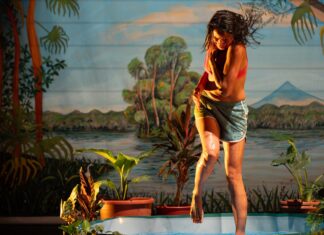A Weimar, nella trentunesima edizione di uno dei maggiori festival tedeschi multidisciplinari e internazionali con la direzione artistica di Rolf C. Hemke. Un reportage in 3 passaggi, arrivo, intervista e racconto.
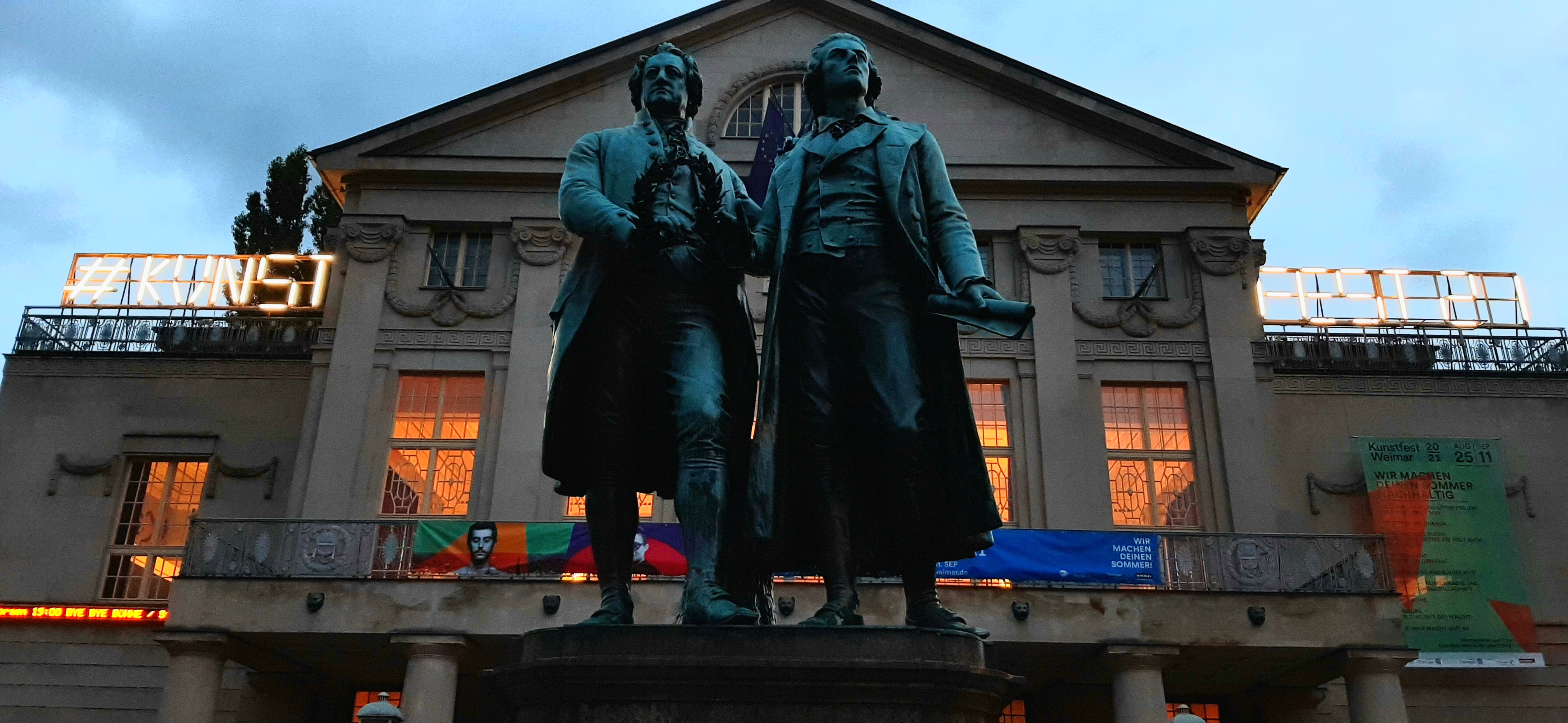
Non avrei mai pensato di partecipare alla festa di compleanno di Johann Wolfgang Goethe. Eppure al mio arrivo all’hotel di Weimar, dove resto per tre giorni, scopro che il 28 agosto proprio lì, di fronte alla casa al Frauenplan che fu del poeta e scrittore, come ogni anno, è in corso questa celebrazione, con un festival del vino e centinaia di thüringer rostbratwurst che sfrigolano sulla brace. Incuriosito, mi raccontano che Goethe amava molto il vino e per la prima volta nella mia vita, brindando alla sua salute, penso che io e Goethe avremmo potuto essere ottimi amici.
Arrivando a Weimar si sente un’eco intellettuale molto forte: è uno dei maggiori centri della cultura tedesca e richiama alla mente, nelle piazze, nei musei, negli spazi culturali e non, i nomi di Goethe, Friedrich Schiller, Frantz Liszt, Friedrich Nietzsche, Johann Gottfried Herder, Arthur Schopenhauer e via dicendo, in una sorta di pantheon tedesco di dèi che sono nati o hanno vissuto e lavorato nella cittadina della Turingia, tra i monumenti della Weimar classica (undici monumenti cittadini inseriti nella lista dei Patrimoni dell’Umanità dell’UNESCO) e l’esperienza artistica del Bauhaus. È in questa culla generativa che dal 1990 si svolge ogni anno a fine estate il Kunstfest. Nella presentazione 2021 firmata dal direttore artistico Rolf C. Hemke, si legge: «l’idea alla base del Kunstfest è non (solo) di usare Goethe, Schiller, Nietzsche e Bauhaus come esempi per questo “spettacolo dello spirito weimariano”. Vogliamo trattare le principali questioni sociali e politiche dopo la pandemia: indagare dove sia diretta la nostra società orientata alla crescita, soprattutto alla luce del cambiamento climatico e della distruzione delle risorse naturali, e trattare temi controversi come la migrazione e l’estremismo di destra, le “fake news” o le imminenti elezioni politiche» (traduzione a cura del redattore).
2. Una conversazione con il direttore
Siedo con Rolf C. Hemke ai tavoli di un ristorante italiano dietro Theaterplatz.
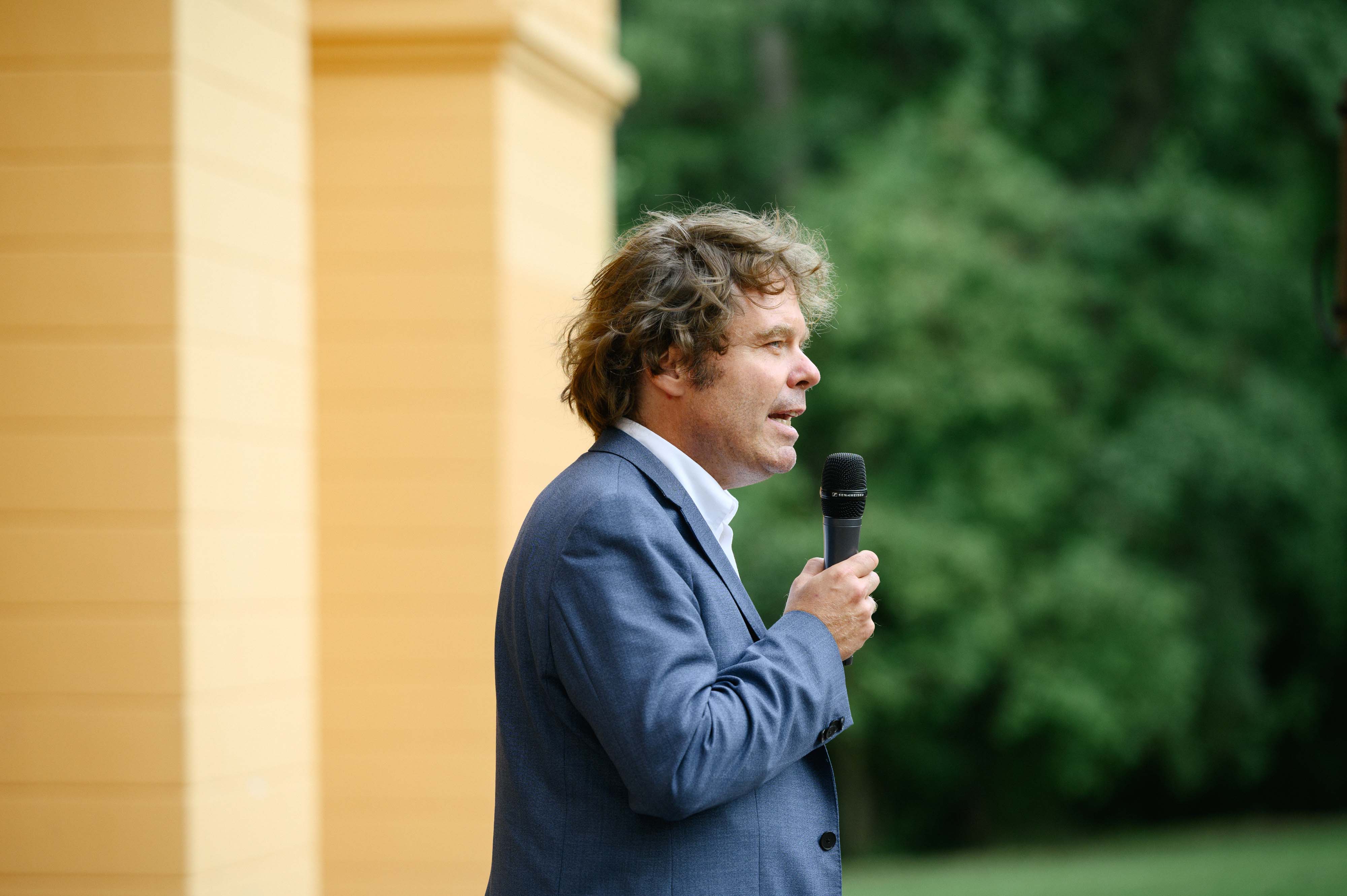
Rolf, questa è la terza edizione del Kunstfest diretta da te. Oltre alle questioni politiche, qual è la direzione che avete preso come squadra rispetto alla tradizione del festival?
Sicuramente abbiamo enfatizzato l’interdisciplinarietà e la vocazione internazionale. Attualmente copriamo quasi tutti gli aspetti della creazione dell’arte contemporanea, il teatro, la danza, le performance e le installazioni, le arti visive, i film, la letteratura, il teatro musicale e i concerti. Per un certo periodo il Kunstfest non aveva definito il proprio contenuto e questa era una peculiarità: la scelta delle discipline da inserire in programmazione cambiava in base ai direttori artistici. Quando sono arrivato ho pensato allora di ritornare all’origine del nome: Kunstfest, “festival di tutte le arti”. Per questo ho scelto di realizzare una programmazione il più larga possibile e allo stesso tempo di imprimere una prospettiva molto contemporanea, puntando sulla creazione, sulle produzioni e sulle co-produzioni.
Passato e futuro, memoria e ricerca. Questa mattina sono stato a Buchenwald, uno dei campi di sterminio più grandi della Germania nazista. Qual è il ruolo che questo memoriale conserva nella storia di Weimar e nel fare cultura oggi?
Per me è un aspetto decisivo di Weimar. Da una parte c’è la gloria della città con i suoi autori e pensatori illustri, ma dall’altra qui è presente anche la vergogna della storia tedesca. È come un’ombra sulla città. Lavoriamo molto con questa memoria, abbiamo in queste edizioni e anche quest’anno ripreso nei giorni di apertura il Gedächtnis Buchenwald Konzert, concerto per la memoria di Buchenwald, ideato quindici anni fa da Nike Wagner, tradizione che era stata poi sospesa. L’anno scorso abbiamo fatto una audio-walk da Weimar a Buchenwald ripercorrendo il cammino dei primi internati e della gente di Weimar che, alla fine della guerra, fu forzata dai soldati statunitensi ad andare a vedere quello che in quegli anni era successo in quel luogo. È una memoria con la quale continuiamo a dialogare costantemente.
Quanto in Germania il lavoro del settore arte è un affare pubblico?
Il Kunstfest gode per un 95% di un sostegno pubblico, proveniente dalla Regione con i fondi della Cancelleria dello Stato, la città e altri organismi pubblici come la Fondazione Nazionale per l’Arte. Un ruolo importante nella progettazione sono poi i partenariati a livello locale; alla creazione del festival partecipano tantissime realtà culturali cittadine, dal Teatro Nazionale alla Fondazione Classica, dall’Università all’Accademia Musicale; è una partecipazione vastissima e varia. Sono una cinquantina i luoghi dove si espande il festival tra città e regione: questo tipo di programmazione diffusa e interdisciplinare non sarebbe mai possibile senza tutta la collaborazione della città e della Turingia.
3. “Music is back! And the shows are back to back. Music is back! So grab your mask and a vax”. Chilly Gonzales
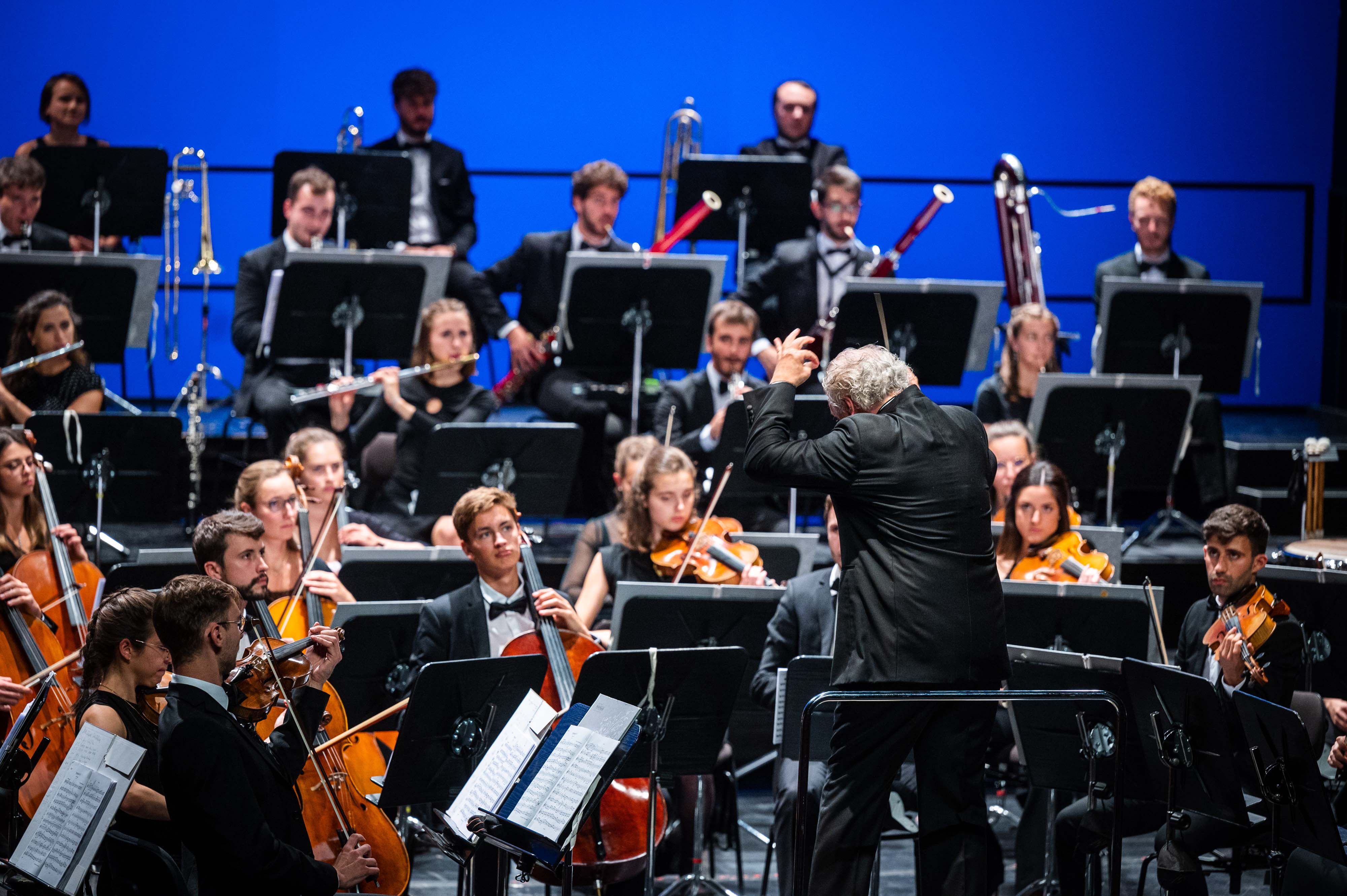
Negli spettacoli scelti dalla direzione artistica ritrovo le parole chiave di Rolf. La mia prima seduta in platea è per ascoltare la Gustav Mahler Jugendorchestrer, l’orchestra giovanile europea fondata a Vienna da Claudio Abbado nel 1986, condotta in quest’occasione da Manfred Honeck con il solista Matthias Goerne, famoso baritono tedesco, anche lui di prodigiosi natali weimariani. Alcuni dei giovani musicisti con i quali mi confronto all’uscita sono spagnoli, e li ringrazio perché sentire l’energia della Sinfonia n. 5 in do minore Op. 67 composta da Ludwig van Beethoven nel Teatro Nazionale è un benvenuto che non lascia indifferenti.
Per la parte politica pago invece lo scotto della lingua, e perdo il significato ma non l’impianto di un progetto da segnalare come il 438 Tage NSU-Prozess che – per l’anniversario dell’identificazione e processo nel 2011 di alcuni membri del NSU (National Socialist Underground), cellula terroristica tedesca di matrice neonazista responsabile di «uccidere per xenofobia e sentimenti anti-statali i cittadini di origine straniera» – ne riporta in scena il processo. All’interno della palazzina Nietzsche-Archiv, la prima istituzione culturale dedicata alla conservazione critico-sistematica del pensiero del filosofo, il processo riprende vita in diciassette capitoli nei diciassette giorni di festival. La lettura drammatizzata delle fasi del processo riapre per gli interpreti e il pubblico le domande, le lacune e gli accadimenti di quell’iter investigativo e della realtà sociale.
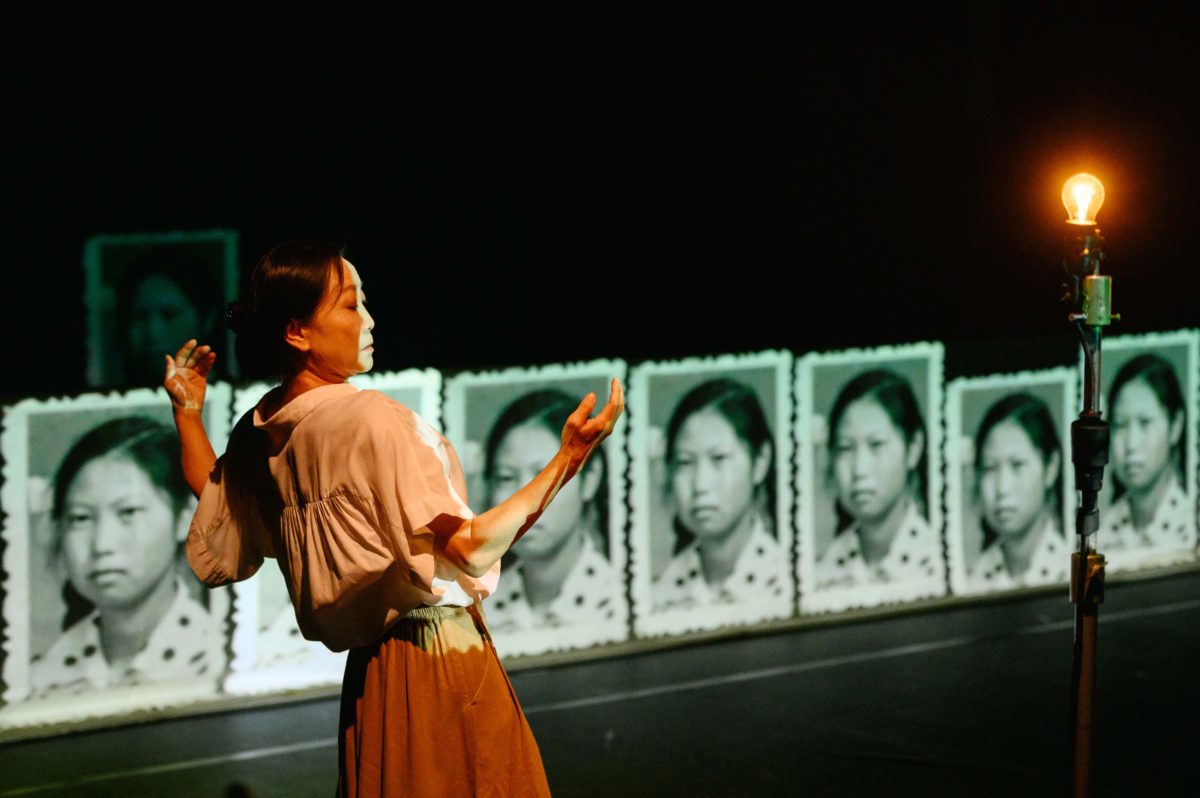
Per la danza, all’interno di una ex centrale elettrica e deposito di tram, oggi lo spazio E-werk, viene presentato l’ultimo lavoro della coreografa cinese Wen Hui, fondatrice nel 1994 della compagnia Living Dance Studio di Beijing con la quale porta avanti una ricerca incentrata sulla memoria e sulle possibilità del corpo di presentarsi come archivio della storia di un popolo. «Nel tempo, i nostri corpi diventano il nostro campo di battaglia»; in I am 60 Wen Hui, attraverso le interviste alla sua famiglia e a giovani donne sulla lotta per l’emancipazione nella società cinese moderna, passando per le immagini e l’uso materico che ne fa su un telo che taglia, brucia e separa le proiezioni, celebra il sessantesimo compleanno del corpo della coreografa e della sua storia. Che cosa resta della “donna nuova” proclamata dai pionieri cinesi del femminismo? Wen Hui incarna la frase di Mao «le donne reggono metà del cielo», dialoga con le radici del femminismo nel cinema cinese degli anni Trenta fino a esplodere, nella scena finale, in una potente “schiera” sospesa nel vuoto, lei e sua madre, in video, ricercandone il ritmo del passo, la forza, la storia.
“Dance with Third Grandma”, un video del 2015 di Wen Hui con una delle donne della sua famiglia che appare anche in I am 60
È sempre attraverso i corpi che, in una prima europea – il debutto è stato a Beirut quest’anno nonostante la pandemia e la situazione libanese – Ali Charour conclude la sua Love Trilogy con Love Behind My Eyes, chiudendo un discorso iniziato nel 2019 sempre al Kunsfest con il primo capitolo. L’opera parte dalla tradizione persiano-araba del “Ghazal”, una forma lirica di poesia di epoca preislamica, che diventa il canto religioso Wa Habibi (mio amato) di Fairouz, un inno cristiano cantato in arabo per il venerdì santo.
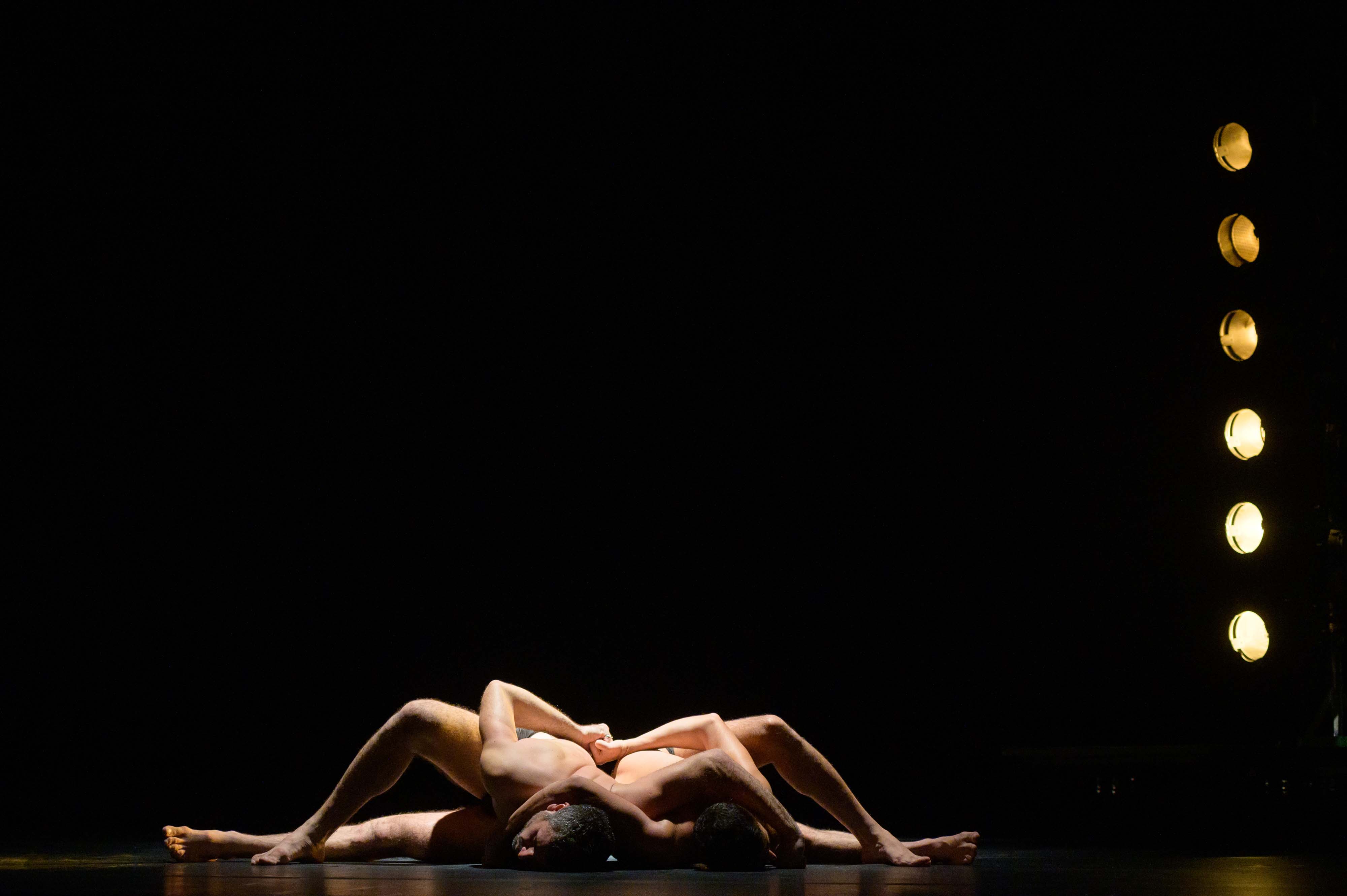
Il canto è affidato a Leila Chahrour; la sua voce ricopre i corpi come il velo straziante e sontuoso della Pietà di Michelangelo, è la devozione mistica di una donna verso il figlio ucciso. L’oggetto religioso si intreccia con sfumature erotiche tra i corpi dei due performer in scena, che si amano, si negano e muoiono. Un contenuto erotico che fa riferimento alla leggendaria storia dello studioso musulmano Mohamed Bin Daoud, che si innamorò a prima vista di un bellissimo giovane di Isfahan fino alla sua morte per l’amore non corrisposto. Religiosamente mascherata nella poesia, la performance di Chahrour può affrontare nei corpi «molte forme d’amore nella sua esibizione che sono altrimenti considerate tabù in gran parte del mondo arabo – a causa di convenzioni religiose, politiche o sociali».
L’arrivederci dal Kunstfest me lo dà Chilly Gonzales, pianista abbigliato in vestaglia e pantofole che scivola come sul marmo lucido di casa tra musica classica, jazz e rap. Chilly Gonzales compone un one-man-show in cui non perde l’occasione di suonare con Stella Le Page al violoncello, Yannick Hiwat al mezzo violino e Amandine Robillard al theremin. Chilly Gonzales gioca con il pubblico, con un dizionario cerca le parole esatte in tedesco per le sue «bullshits», ma soprattutto dà al pianoforte il potere della percussione; plasma la materia ritmica generando dal 5/4 di Take five di Dave Brubeck, dapprima un tempo di valzer per giungere all’ossessione sincopata del tempo in 1/4. Chilly Gonzales invoca le ovazioni del pubblico, è un tormentone estivo suonato da Bach e allo stesso tempo musica da camera mentre fuori c’è la tempesta. L’artista chiude il concerto con una delle sue ultime composizioni, Music Is Back, come urlo liberatorio post-pandemico. In platea si balla da seduti, si battono le mani, poi uno alla volta ci alziamo tutti non so se per ballare o se in una standing ovation o per riabituarci semplicemente a farlo. «Music is back!», diciamo tutti, invocando qualcosa, elettrizzati. Chilly Gonzales gronda di sudore perché stasera «music is back» and «I’m jacked with this battery pack strapped to my back».
Luca Lòtano
Kunst! Contemporary art at Weimar’s Kunstfest
The thirty-first edition of one of Germany’s leading international, multi-artform festivals. Artistic direction by Rolf C. Hemke.
1. Wilkommen in Weimar!
I never would have imagined myself attending a party for Johann Wolfgang Goethe’s birthday. And yet, as I’m checking into my hotel in Weimar, where I’ll be staying for the next three days, I realize that precisely such a celebration is underway – as it is every year – just down the road in front of the writer’s home. A wine festival with hundreds of thüringer rostbratwurst sizzling on the grill. Intrigued, I draw near. I’m told that Goethe loved wine, and for the first time in my life, raising toasts to his health and memory, I think that Goethe and me could have been great friends.
One immediately gets a strong intellectual vibe from Weimar. It’s a center of German culture, with its museums and squares evoking names like Goethe, Friedrich Schiller, Frantz Liszt, Friedrich Nietzsche, Johann Gottfried Herder and Arthur Schopenhauer. Even its non-cultural spaces breathe thought. It’s a kind of pantheon to all the German gods who were born in this small Thuringian city, or who lived and worked here among the monuments of classic Weimar (eleven UNESCO sites) and the more recent artistic experience of the Bauhaus. This is the creative hub that Kunstfest has called its home every summer since 1990 and, presenting this year’s edition, artistic director Rolk C. Hemke writes: “The idea behind the KUNSTFEST is not (just) to use Goethe, Schiller, Nietzsche and Bauhaus as examples for this Weimar ‘Bundesgeisteschau’. We want to negotiate the key societal and political issues after the pandemic — both on stage and through discussions: for example, the question of where our growth- oriented society is headed, especially in light of climate change and the destruction of the natural re-sources we need to live. But the pandemic has also catalysed other serious problems, and these are being raised with new vehemence in political and social discourse. As a result, you will also find projects or ‘artistic commentary’ on controversial topics such as migration and right-wing extremism, ‘fake news’ or the up- coming elections.”
2. A conversation with the director
I sit down with Rolf C. Hemke at an Italian restaurant behind the Theaterplatz.
Rolf, this is the third edition of Kunstfest that you’ve directed. Beyond the political questions, what direction have you taken as a team in regards to the festival’s tradition?
We definitely had an interdisciplinary and international focus. We currently cover almost all sides of contemporary art creation: theater, dance, performance art and installations, visual art, film, literature, musical theater and concerts. There was a time when Kunstfest didn’t define its content, the choice of which forms to include in the programming changed according the artistic director. When I got here I wanted to return to the roots of the name: Kunstfest, “festival of all arts”. So I decided to create as wide a program as possible, and to give it a very contemporary perspective at the same time, one that focused on creation, production and co-production.
Past and future, memory and research. This morning I went to Buchenwald, one of Nazi Germany’s largest concentration camps. What role does this memorial still play in Weimar’s history and in cultural creation today?
For me its a crucial aspect of Weimar. On the one hand there’s the glory of the city with all its illustrious authors and thinkers, but on the other there’s the shame of German history here. It’s like a shadow on the city. We work a lot with this memory: in recent editions we’ve brought the Gedächtnis Buchenwald Konzert back as part of the festival’s opening, a concert for the memory of Buchenwald that was started fifteen years ago by Nike Wagner, a tradition that was later interrupted. We did it again this year. Last year we did an audio-walk from Weimar to Buchenwald, retracing the steps of the first prisoners, as well as the people of Weimar who, at the end of the war, were forced by American soldiers to go see what had happened in that place in those years. We’re in constant dialogue with the memory.
In Germany, how much is the art sector a matter of public concern?
95% of Kunstfest is funded by the public, whether it be the State Chancellory, the city or other public organisms such as the National Art Foundation. And local partners play an important role in programming. A large number of civic cultural groups contribute to the festival’s creation, from the National Theater to the Classical Foundation, the University and the Musical Academy – there’s a really wide and varied participation. The festival has about fifty locations throughout the city and region: this type of diffused and interdisciplinary programming wouldn’t be possible without the collaboration of the city and the state of Turingia.
3. “Music is back! And the shows are back to back. Music is back! So grab your mask and a vax”. Chilly Gonzales
Rolf’s words echo through the performances. I first go to hear the Gustav Mahler Jugendorchestrer, the European youth orchestra founded in Vienna by Claudio Abbado in 1986, now conducted by Manfred Honeck and aided by soloist Matthias Goerne, the famous German baritone, he too of prodigious Weimarian birth. I wait around after the show and meet some of the musicians. They’re Spanish. I thank them, because witnessing the energy of Beethoven’s Sympphony No. 5 in C minor Op. 67 in the National Theater is a rather unforgettable welcome.
As far as politics goes, I pay a bit for my lack of German. But while I lose the detail, I don’t lose the overall significance of the memorable project 438 Tage NSU-Prozess which, to mark the anniversary of the 2011 identification and trial of certain members of the National Socialist Underground – the German neo-nazi terrorist cell responsible for having “murdered citizens of foreign backgrounds for xenophobic and anti-government sentiments” – puts the trial on stage. Inside the Nietzsche-Archiv, the first cultural institution dedicated to the critical-systematic conservation of the philosopher’s thought, the trial is brought to life in seventeen chapters spread across the seventeen days of the festival. The dramatized reading of the trial’s various phases revives all the questions and doubts surrounding the investigative procedure, and the social reality it implies.
I get to see some dance, too. Inside the ex-power plant and tram depot, now a space called E-werk, Chinese coreographer Wen Hui’s latest piece is presented. Wen Hui founded the Living Dance Studio company in Beijing in 1994 and it’s still the vehicle for her ongoing research on memory, and the body’s potential to be an archive for the story of a people: “over time, our bodies become our battleground”. In I Am 60, Wen Hui celebrates the sixtieth birthday of her body, her story. Interviews of family members and of young women on the struggle for emancipation within modern Chinese society aid her in this celebration, as do various images projected onto a cloth which she then cuts and burns, breaking up the representations. What remains of the “new woman” proclaimed by the pioneers of Chinese feminism? Wen Hui embodies Mao’s phrase “women hold up half the sky”, dialoguing with the feminist roots found in 1930s Chinese cinema before exploding, in the final scene, into a powerful “schiera” suspended in the void: she and her mother, in video, seeking together the rhythm of their steps, their strength, their story.
Sticking with the body, Love Behind My Eyes is dancer and choreographer Ali Charour’s closure to the conversation he began at Kunstfest in 2019 with the first chapter of his Love Trilogy. Debuted this year in Beirut despite the pandemic and the Lebanese situation, the piece moves within the Arabic-Persian tradition of “Ghazal”, a pre-Islamic form of lyrical poetry that would later become Fairouz’ song Wa Habibi (my love), a Christian hymn sung in Arabic for Good Friday.
The singing is entrusted to Leila Charour, and her voice blankets the bodies like the lavishly heartwrenching veil in Michelangelo’s Pietà. It is the mystical devotion of a woman for her slain child. The religious object mixes with erotic undertones in the bodies of the two performers on stage. They love each other, reject each other and die. There’s an erotic content alluding to the legendary story of Muslim scholar Mohamed Bin Daoud, who fell head over heels for a beautiful young man from Isfahan and later died from unrequited love. Religiously masked in its poetry, Chahrour’s performance can, through the body, address “many forms of love in its performance that are otherwise considered taboo for a large part of the Arab world – be it for religious, political or social conventions.”
My farewell to Kunstfest came in the form of Chilly Gonzales, a pianist dressed in slippers and robe who slides between classical music, jazz and rap like socks over marble. Chilly Gonzales is a one-man-show, yet he doesn’t miss the opportunity to play with Stella Le Page on cello, Yannick Hiwat on violin and Amandine Robillard on theremin. Chilly Gonzales toys with the public, looking up the German words for his “bullshitting” in a dictionary, but above all else he gives the piano a percussive power; he molds the rhythmic material generated by Brubeck’s Take Five and its 5/4, starting it off as a waltz before eventually reaching the strange syncopated obsession of 1/4 time. Chilly Gonzales gets an ovation from the crowd, he’s the song of the summer played by Bach, he’s chamber music with a thunder storm raging. The artist wraps up the show with one of his most recent compositions, Music is Back, a liberating post-pandemic howl. The crowd dances in their seats and claps their hands. Then, one by one, we all stand up, though whether we do so in ovation or to dance better or simply to rediscover this old habit I’m not so sure.”Music is back!” we yell, electrified, invoking something we didn’t know was there. Chilly Gonzales is dripping in sweat, and for good reason: “music is back” tonight and “I’m jacked with this battery pack strapped to my back.”
Traduzione Jack Spittle





